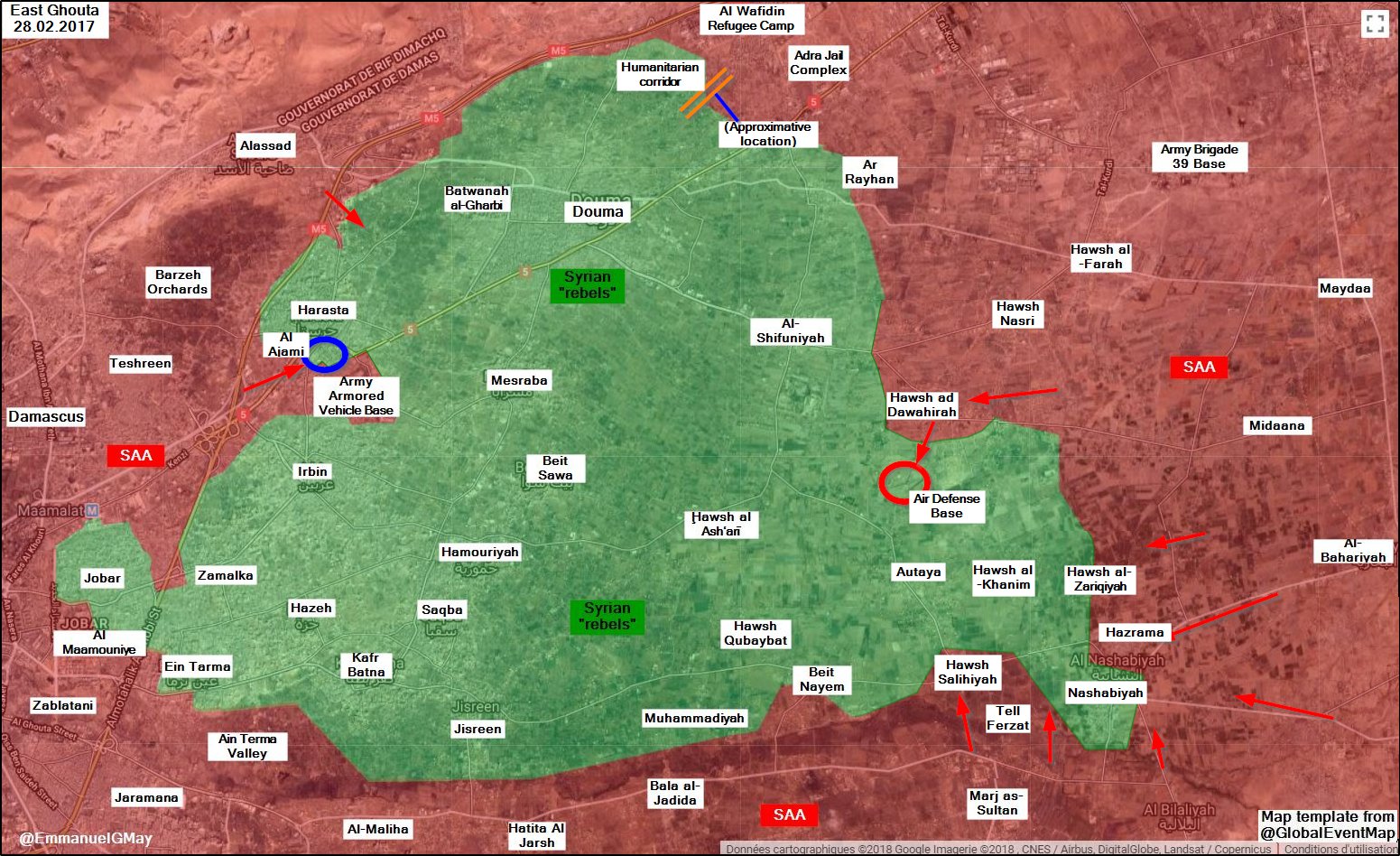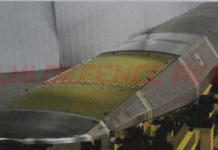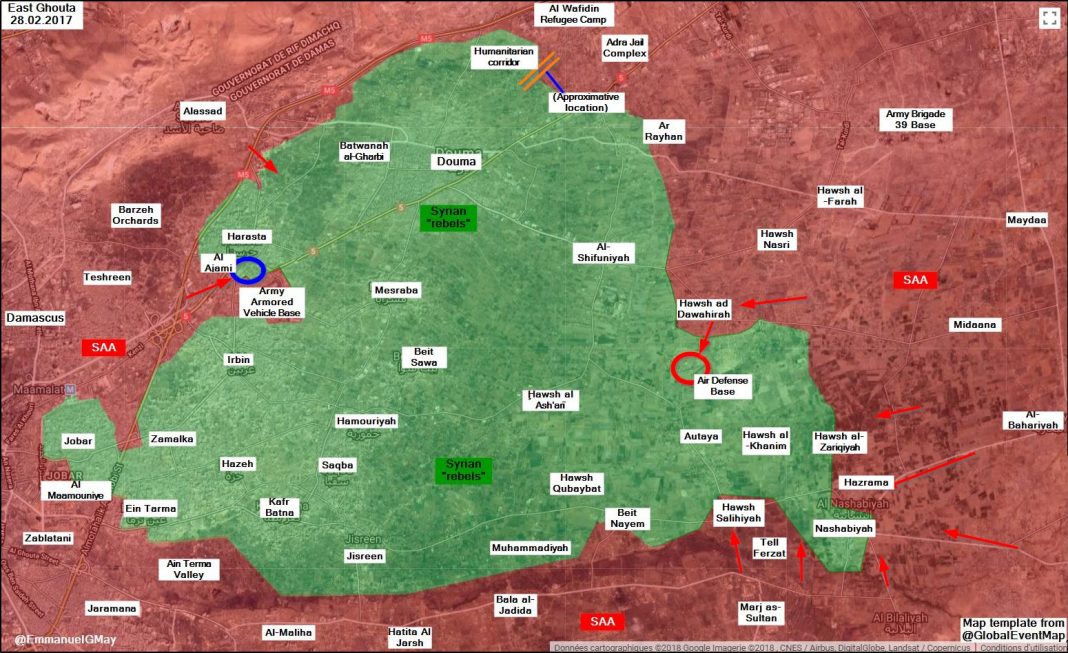Barely 10 days into the East Ghouta offensive, the Tiger Forces and the Republican Guard have managed to penetrate deep into Jaish al-Islam’s (JAI’s) logistic and communication line in the centre of the rebel-held bastion. The entire 12 km defensive belt – dubbed by rebels “The Trench of Death” – linking Nashabiya to Rayhan has been blasted to smithereens as Syrian Arab Army (SAA) shock troops have captured the Air Defence (AD) base and the army base along with Hawsh al-Dawahira, Utaya, Nashabiya, and Zriqa. Parallel advances by the 4th Division of the SAA in Harasta in Ghouta’s western sector threaten to trigger a total collapse in the rebel defences emplaced around Douma.
These parallel advances are progressively cutting the major logistic and communication lines in central Ghouta. With reports of the fall of Shifuniya , JAI is now in an untenable position – all the villages and farmland south of Shifuniya are bound to fall – causing a drastic shrinkage of the pocket. As of now, Mesraba is all that stands before total isolation of Douma from the rest of Eastern Ghouta and it too is likely to fall soon enough.
Overall, Syrian forces on both sides of Al-Ghouta are inching closer to the goal of isolating Douma. As predicted, the operational memorandum of the East Ghouta offensive is to utilize sheer firepower to break through the sparsely-urbanized eastern sector before launching a two-pronged attack on Mesraba and Harasta to separate JAI in Douma from Faylaq al-Rahman south of Harasta.
Background

Image: Battle Position in East Ghouta. Image Credit: @EmmanuelGMay via twitter
The western fronts of Eastern Ghouta present an urban terrain littered with mines, booby traps, IED-laced building blocks, and ambush crossfires planted at every turn and corner. These unappealing features doomed previous loyalist offensives in Jobar and Ayn Tarma to premature failure. Though the rebels of JAI have succeeded in setting up a standing line of defense in the eastern sector of the Ghouta bastion extending from Nashabiya all the way to Reyhan (roughly 12 km in length), the SAA’s Republican Guard and the 4th Division could theoretically cut through the farm area in a mechanized assault through sheer overwhelming fire power reducing the insurgent bulwark to just an urban strip extending from Ayn Tarma to Douma. A two-pronged assault at Mesraba and Harasta could then be initiated to permanently separate the rebels of JAI from their counterparts of Faylaq ar-Rahman (FAR) and HTS in Erbeen and Zamalka.
However, within this small pocket that barely exceeds 150 sq. km in size, there is a constantly evolving political landscape that complicates the dynamics of this Damascene battlefield, already ripe with countless entanglements. The Syrian government has found in JAI a faction willing to negotiate and potentially reconcile when subjected to the right amount of pressure. The government has in fact pushed JAI to assault their rivals within East Ghouta several times in an attempt to claim a monopoly of power in the area. This has resulted in bloody confrontations that have cost rebels hundreds of casualties. In addition, there has been a loss of popular support from the local population that has suffered a gruelling siege as local warlords allegedly hoard humanitarian aid and resources. So far, these intra-rebel conflicts have failed to yield any notable shift in the balance of power.
Incapable of providing the waning JAI with air support against the Muslim Brotherhood-tied FAR due to political reasons and lacking a desire to subject JAI to a costly war of attrition on the eastern and southern fronts due to justified fears of a FAR and HTS takeover in East Ghouta, the SAA was unfavourably coerced into launching brutish assaults on the static western front lines under the wishful impression that a breakthrough would lead to an irreversible collapse of FAR and a broad conclusive peaceful resolution to the conflict in Eastern Ghouta. With last week’s gains, it is clear that all that has changed, and the SAA has been given full rein, with military considerations trumping political ones.
The deployment of the formidable Tiger Forces to the east Damascus theatre as expected has proven to be the deciding factor in this confrontation.
Izat Charkatli is a regular contributor to AMN and a biomedical engineering student with some military experience
© Delhi Defence Review. Reproducing this content in full without permission is prohibited.
































